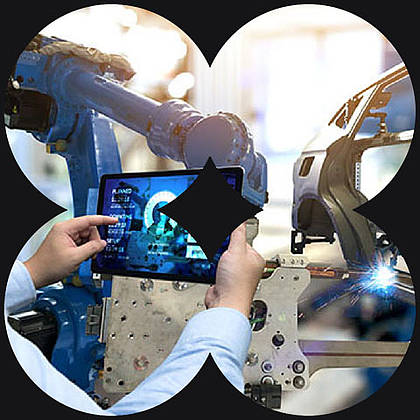Advantages of our Computer on Module solutions
- Ready-to-use computing engine, integrate with a product-specific carrier board
- ARM, x86, and FPGA processors
- Matching Board Support Package (BSP) with source code
- Linux, Android, Windows Embedded operating systems, Windows 10 IoT Core operating systems
- Highly configurable
- Extensive form-factor portfolio from 33 x 49 mm to 125 x 95 mm
- Long-term availability, 10+ years
- Industrial temperature, conformal coating options
- Development kits for easy evaluation and early application development
- SECO design services for custom carrier boards
- Custom COM design available
Industry Standard Modules

COM Express
Perfect for fast and economical personalisation of projects. The performance of this COM series can be easily scaled and thus adapted to e.g. graphics performance requirements.

COM-HPC
This product family is available in two versions: the "client" version as a classic embedded system and as a natural evolution of the Com Express 6. The "server" version supports networking with broadband Ethernet.

ETX
Ideal for projects within a proven framework. This COM counts as a mature and reliable standard.

QSeven
Compact, power-saving, scalable and highly efficient in use.

SMARC
Ideal for projects that require high performance and low power consumption.
Proprietary COM Standards

Myon
COM class with particularly compact form factor, low power consumption and high speed ARM architecture. Primarily used in small IoT and battery-powered handheld devices.

Trizeps
Is characterised by the consistent SODIMM form factor. This enables a short development time and easy upgradeability - at a low cost.
Compare the sizes of SECO's extensive portfolio of COM boards
Our extensive range of form factors means you can always make the right choice for your end device. Choose a small form factor, such as Myon, Trizeps, uQseven, or SMARC for small, handheld and portable electronic devices. Choose COM Express and COM-HPC modules for high performance, more powerful, but not as space constrained applications, such as complex machinery, rugged box computers, and higher performance sensor processing nodes.
What is a Computer on Module?
COM technology provides a complete, verified computing engine on a circuit board for integration into an embedded product. Utilizing a COM enables engineering teams to focus on implementing their company’s core competencies and added value – leveraging a commercial off-the-shelf processing solution - thus reducing the complexity, risk, development time, and engineering costs of the product design team.
The COM (also known as a System on Module (SOM)) minimally includes a CPU, memory, storage, power management, and other support functions. Many COM boards also implement additional functions such as Wi-Fi® and Bluetooth®. This relatively small, high density circuit board is mounted onto a product-specific carrier board. Using defined standards with fixed pin-outs, COM modules within a form-factor are upgradeable as processing technology advances.
SECO COM solutions include a corresponding operating system, a Board Support Package (BSP), and a software development kit (SDK). This allows software developers to implement their applications relatively quickly.
Upgradeability through extensive pin compatibility
In addition to our standard modules, we also offer module boards with their own form factor and extensive pin compatibility (e.g. through the SODIMM standard). These modules (Trizeps and Myon) are particularly suitable when customer projects require extremely special specifications or find their use in handheld devices. Thanks to our own form factor, we can implement the requirements on the module in a very short time without having to start a completely new development. The standard is maintained by us up to the latest solutions Trizeps VIII Mini and Trizeps VIII Plus with i.MX 8M Mini and i.MX 8M Plus.
The advantages of SECO COM technology at a glance
- All critical components are available on the COM CPU modules, thus reducing the hardware design effort on the customer's side.
- The customer's remaining hardware design only includes interface connections in the form of a baseboard.
- The SODIMM contact system of the CPU modules is absolutely "ruggedised" and is used in extreme scenarios.
- Due to their design, our COM CPU modules can be integrated into almost any housing.
- An early start of software development is made possible with a reference design of our evaluation kits or baseboards.
- The Board Support Package (BSP) developed by SECO allows the individual integration of customer-specific drivers. In addition, software development kits (SDK) are available for the development of customer applications.
- As a long-standing Microsoft Gold Partner, we can quickly implement projects with Windows Embedded operating systems (CE 5.0, CE 6.0 R3, Compact 7 and 2013) as well as Windows 10 IoT Core.
- In addition to a Microsoft solution, SECO offers an Android/Linux development set. This set provides a virtual machine with Ubuntu LTS, which contains a specific BSP and with which an OS image for COM CPU modules can be generated straightforwardly.
Areas of application

Pioneers of ARM-based COM technology
The world's first ARM-based SOM (System On Module), also named COM, came from our production facility in Wuppertal (formerly Keith & Koep). The Trizeps I was the first to implement the idea of making the recurring core elements available in an embedded system in the form factor of a SODIMM CPU module. With this system, development times could be significantly shortened and a faster "time-to-market" realised.
This idea became established step by step and is now used worldwide, among others in industrial and medical technology areas. Later, this system became the international industry standard. The first CPU module generation had the SODIMM 144 standard, which was subsequently replaced by the SODIMM 200 standard due to the need for more and more interfaces.
The Myon module series launched a new COM generation with a very compact form factor, making them easy to integrate into high-performance IoT and battery-powered handheld devices.










